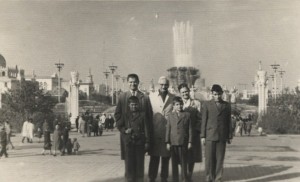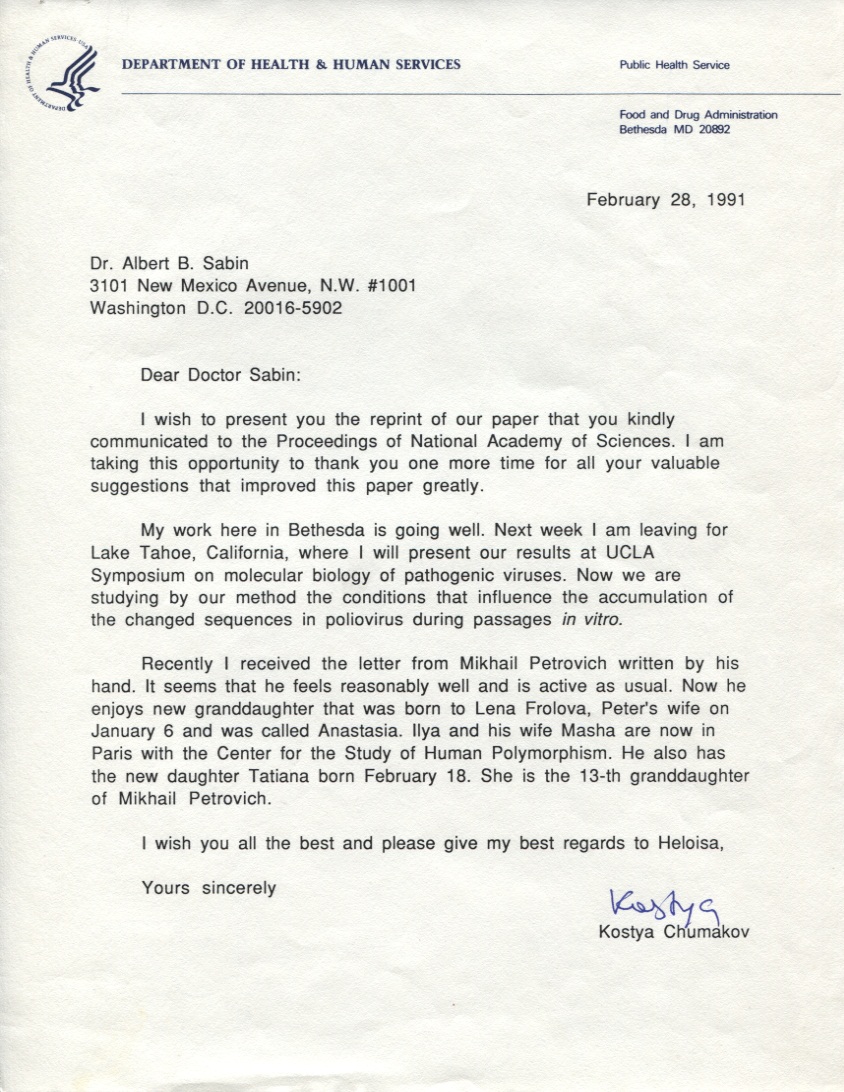Recently, I wrote a blog post about an article that appeared in a recent issue of Scientific American about Drs. Sabin and Chumakov and their cooperation when testing the oral polio vaccine during the Cold War. Through the author of the article Mr. William Swanson, I was connected with Dr. Konstantin Chumakov, son of Dr. Mikhail P. Chumakov. Yesterday, I had the chance to speak with him about his father and Dr. Sabin. I wanted to share a bit about our conversation, as well as some materials in our collection.
For those of you that don’t know, Dr. Sabin kept everything. So it was not a surprise to me that we have a folder in the “Correspondence” series of the Sabin collection that contains letters to and from Dr. Konstantin Chumakov. Most of these letters are about an article that Dr. Chumakov and his colleagues wrote for the Proceedings of the National Academy of Sciences (PNAS), which Dr. Sabin sponsored. However, there is a photograph (seen to the left) which is labeled “Moscow, 1961.” According to the photograph, “Kostya” (Dr. Konstantin Chumakov) is the first child from the left, standing in front of his father.
According to a letter written by Dr. Sabin, he had known Konstantin since he was four years old. He wrote, “I had an opportunity to see [Konstantin] grow and develop into the excellent molecular biologist that he has become. […] He has become an important member of a research team working on molecular biology problems of the oral polio vaccine that bears my name and on other problems.”[1]
When asked about Dr. Sabin, Dr. Chumakov remembered his visits to Moscow, where Dr. Sabin was invited to the Chumakov household for nice dinners. He remembers thinking of Dr. Sabin as a nice man and “grandfatherly figure” at that time.
Years later, Dr. Chumakov came to the United States to work on the polio problem at the U.S. Food and Drug Administration. When he wanted to publish a paper on polio in PNAS, he asked for Dr. Sabin’s assistance. At first, Dr. Sabin said no, saying he didn’t do those things any more. (He was in his 80’s after all.) But then he changed his mind. A couple days later, he called Dr. Chumakov, telling him that he would help him as long as certain changes were made in the publication. So Dr. Chumakov visited Dr. Sabin at his apartment in Washington DC on several occasions while editing the article. He recalled Dr. Sabin’s amazing organizational skills and memory. He noted that Dr. Sabin would remember a relevant topic, go to the closet where all of his files were kept, and pull out the exact file he needed to illustrate a point.[2]
Throughout the process, Dr. Sabin corresponded with the article reviewers and with Dr. Chumakov. After some edits, Dr. Sabin submitted the article to PNAS, saying, “The work described in this manuscript is in a field in which I have worked for about 40 years. Both referees who are acknowledged experts in molecular genetics agree with me that it qualifies for publication in the Proceedings. I believe that this contribution is of general scientific interest […]”[3]
The first article written by Dr. Konstantin Chumakov and his team on polio is called, “Correlation between the amount of virus with altered nucleotide sequence and the monkey test for acceptability of oral poliovirus vaccine” was published in the January 1991 issue of PNAS. The free full text version of the article can be found on Proceedings of the National Academy of Sciences website (volume 88, pages 199-203).
After the article was published, Dr. Chumakov sent Dr. Sabin a letter (seen above), along with a reprint of the article. At the top of the reprint, Dr. Chumakov wrote, “To Dr. Sabin with admiration and many thanks for invaluable help.”[4]
References
Letters mentioned in this blog post can be found in Series #1 – Correspondence, Sub-series Individual, Box #5, Folder #1 – Chumakov, K.M., 1990-1993.
[1] Letter from Dr. Sabin to the U.S. Immigration and Naturalization Service, 4 March 1992.
[2] Interview with Konstantin Chumakov, 26 April 2012.
[3] Letter from Dr. Sabin to the Proceedings of the National Academy of Sciences USA, 9 October 1990.
[4] Letter from Dr. K. Chumakov to Dr. Sabin, 28 February 1991.
In 2010, the University of Cincinnati Libraries received a $314,258 grant from the National Endowment for the Humanities (NEH) to digitize the correspondence and photographs of Dr. Albert B. Sabin. This digitization project has been designated a NEH “We the People” project, an initiative to encourage and strengthen the teaching, study, and understanding of American history and culture through the support of projects that explore significant events and themes in our nation’s history and culture and that advance knowledge of the principles that define America. Any views, findings, conclusions, or recommendations expressed in this blog do not necessarily reflect those of the National Endowment for the Humanities.


